- Home
- Julian May
The Nonborn King Page 2
The Nonborn King Read online
Page 2
Felice coveted Epone's golden tore, knowing that the mental amplifier was capable of releasing the great metafaculties now locked within her brain. But before she could take the tore from the Tanu woman's body, mad Dougal grabbed it and threw it into the lake. Amerie had to drug Felice with a sedative to prevent her from killing Dougal.
Bewildered and frightened, the exprisoners realized that news of the fight must have been telepathically flashed by the dying Epone to the nearest fort They would have to disperse quickly. One group elected to follow Basil, the exdon. They would sail in small boats down the Lac de Bresse to the Jura Mountains.
Claude, the 133-year-old paleontologist, was more wilderness-wise after years of roughing it on wild planets in the Milieu. He advised his friends of Group Green to avoid the open lake and instead head into the heavily forested Vosges Mountains, which were much closer than the Jura. The surviving samurai warrior, Yosh, decided to go his way alone, heading north in hopes of reaching the sea.
The large group of escapees out on the lake was eventually almost entirely recaptured and taken in chains to the city of Finiah. But Claude, Richard, Amerie, and Felice went deep into the Vosges, where they finally made contact with a group of free outlaw humans, fugitives from Tanu settlements, who called themselves Lowlives.
The Lowlife leader was an old woman, Angélique Guderian, former keeper of the time-gate and the ultimate author of Pliocene humanity's degradation. Around her neck was a golden tore, the gift of the Firvulag, those deadly enemies of the Tanu, who had formed a very tentative alliance with the Lowlives. Madame had modest metapsychic powers.
***
The killing of Epone by the escapees was unprecedented. Never before had a mere human been able to bring about the demise of one of the tough exotics, who normally enjoyed life spans of hundreds of years. Tanu searchers, under Lord Velteyn of Finiah, now swarmed the Vosges region, looking for the ones who had done the deed. The remnant of Group Green, together with Madame Guderian and some 200 Lowlives, hid in a great hollow tree until things should cool off. Inside the refuge, Madame explained to the newcomers her great plan to free Pliocene humanity from the Tanu yoke, a task she had undertaken in order to expiate her own guilt.
Madame's deputy, a Native American named Peopeo Moxmox Burke, who had once been a judge, was keenly interested in Amerie's theory about the deadliness of iron to the exotic race. This might be an invaluable secret weapon in the liberation of humanity.
A friendly Firvulag named Fitharn Pegleg joined the Lowlives inside their sanctuary and told Group Green the legend of the Ship's Grave. The great space-going organism that was Brede's mate had died in making the leap from its home galaxy to our own. Tanu and Firvulag, passengers in the Ship led by Brede, escaped from the hulk in small flying machines just before it impacted upon the Earth, making a great crater known as the Ship's Grave.
For some time, Lowlives, working with Firvulag, had searched for this ancient site. Even though a thousand years had passed, it was possible that some of the sophisticated flying machines left at the Grave might still be operational. And inside one of them, entombed after a ritual duel, was the body of Lugonn, Shining Hero of the Tanu, together with his sacred weapon, the Spear. The latter was not a blade, but rather a photonic projector that delivered laserlike blasts of energy. This Spear, in the hands of Lowlife humanity, could turn the balance of power.
Madame's people had looked in vain for the Ship's Grave. But Claude, knowledgeable in future geology, told them that the crater could only be the astrobleme known as the Ries, located some 300 kilometers to the east, beyond the Black Forest, on the northern shore of the Danube River.
It was decided to mount a new expedition at once. With luck, the searchers might return before the end of September. The Firvulag would then join humanity in a joint attack against the city of Finiah—provided that the fighting took place before the start of the Grand Combat Truce, which began at dawn on October 1. Unknown to Fitharn, who agreed to accompany the party, the Lowlives who remained behind intended to go to another site designated by Claude, where they hoped iron ore might be found. They would smelt whatever iron they could and then forge weapons to be used in the Finiah attack. The iron was to be kept a secret from the Firvulag, since Madame was dubious of their loyalty.
After receiving permission from Yeochee IV, King of the Firvulag, the expedition set out. It comprised Madame Guderian, Richard, Felice, Chief Burke, a former aircraft technician named Stefanko, a dynamic-field engineer named Martha, Claude, and Fitharn. Felice was especially anxious to go. She was certain that the body of the ancient hero, Lugonn, would have a golden tore about its neck that she could appropriate.
Disaster struck the party even before it reached the Black Forest. In a Rhineside swamp, a giant pig killed Stefanko and badly wounded Chief Burke. Frail Martha, who had borne four children in quick succession as a Tanu slave, began to hemorrhage from the shock. It seemed that the expedition would have to be abandoned. But Martha insisted that she would recover, and Felice agreed to carry the sick woman if need be. Martha was a vital member of the group, now the only one with the technical skill to put the photon Spear and/or a flyer into operation once the expedition found them. The Firvulag Fitharn agreed to take Chief Burke back to the Lowlife village of Hidden Springs, where Amerie was recuperating from a broken arm.
After many vicissitudes, the reduced expedition crossed the Black Forest range and came into the territory of a certain Sugoll. Only nominally under the authority of the Firvulag King, Sugoll ruled a large band of grotesque mutant Firvulag called Howlers. His own hideously deformed body was hidden beneath a handsome illusion. Sugoll at first scorned to assist the expedition and threatened to kill the humans. But when Claude pointed out the source of Howler deformity—radioactive rocks among which they had lived for many generations—the ruler relented. Claude hinted that the Howlers might relieve their plight by seeking help from human geneticists—if such persons were released from Tanu slavery. The liberation of humanity (and helping out the expedition) was thus to the Howler advantage. Sugoll finally agreed to assist the party in finding the River Danube, on which the humans could easily voyage to the Ship's Grave. Once again the four travelers set off.
On 22 September they arrived at last at the crater. Richard and Martha, who had become lovers, set about repairing one of the flying machines and the great Spear. Felice, after a fit of rage brought on by her discovery that Lugonn's skeleton had no golden tore, calmed herself and was a model of cooperation. Even so, time was getting desperately short if they were to meet the deadline before the Grand Combat Truce. Martha's old affliction returned and she grew dangerously weak from loss of blood; but she would not let them return to Hidden Springs until the testing of the photon weapon was complete.
***
Meanwhile, a great Firvulag army had gathered on the bank of the Rhine opposite the Tanu city of Finiah. Additionally, several hundred Lowlives had been recruited from scattered wilderness hamlets and surreptitiously armed with iron. At dusk on the twenty-ninth the flyer finally landed at Hidden Springs with the Spear ready for use. But Martha was in shock from hemorrhaging, and Amerie could only rush her away for transfusions and pray for a miracle. The distraught Richard could not even remain with his beloved; he had to pilot the flyer in its bombardment of Finiah.
Screened by Madame Guderian's limited metapsychic power, the flyer hovered over the city while Claude blasted holes in both city walls. Then he turned the Spear on Finiah's barium mine, the only source in the Many-Colored Land of the element that was vital in making all kinds of tores. The mine was destroyed, and waves of Firvulag, wearing the illusory shapes of hideous monsters, invaded the city alongside Chief Burke and his Lowlife forces. After a desperate fight, Finiah fell. Its surviving Tanu populace, including the ruler, Lord Velteyn, fled in the direction of Castle Gateway. The erstwhile human slaves (some of whom had been quite content in their bondage) were given the choice of freedom or death. Those wearing gray
or silver tores had to submit to their removal with an iron chisel, a painful process that left many of them in a state of profound nervous collapse.
Both Claude and Madame were wounded by bolts of Velteyn's psychoenergy during the air attack. Richard lost the sight of one eye, but managed to return the flyer safely to Hidden Springs. There he discovered that Martha had died. Mad with grief, he took her body and soared away in the gravomagnetically powered aircraft, to wait for his own death in an orbit thousands of kilometers above Pliocene Earth.
Below, Felice was walking toward the ruins of Finiah. She bitterly regretted missing the war, but she knew that she would find her long-sought golden tore somewhere in the devastated city, and then she would attain the powers needed to fulfill her vow to destroy the Tanu race. Felice finally did find a tore; it raised to operancy her latent powers of farsensing, psychokinesis, coercion, and creativity. Some time would have to elapse before she learned to use these powers correctly, and so she returned to Hidden Springs in order to assist Madame Guderian in the next phases of the liberation of humanity.
Meanwhile, far to the south in the Tanu capital of Muriah, the other four members of Group Green encountered an utterly different face of the Many-Colored Land.
***
Upon their arrival, the Green quartet and their fellow humans, Raimo and Sukey, were presented to the Tanu aristocracy at a lavish feast. Elizabeth learned from Thagdal the High King that she was to be taken to Brede Shipspouse in order to be initiated into Tanu ways—an unprecedented honor. After the initiation, which might take a month, she would be impregnated by the King and found a new dynasty of fully operant (i.e., torcless) Tanu-human hybrids. Queen Nontusvel seemed entirely agreeable to this arrangement and Elizabeth herself showed no emotion as Thagdal unfolded his plans.
The other honored prisoners learned their own fates. Bryan the anthropologist was commanded to make a careful study of the impact of humanity's advent upon the Tanu socioeconomy. A certain faction, headed by Nodonn Battlemaster, the most powerful son of Thagdal and Nontusvel and heir presumptive, maintained that the coming of humanity had been detrimental to Tanu culture rather than beneficial, as Thagdal and most of the Tanu aristocracy believed. Bryan, using the advanced analytical methods of the Milieu, was to settle the matter. It went without saying that Thagdal felt confident that Bryan would confirm the royal policy.
The gigantic Viking Stein, Raimo Hakkinen, and Sukey Davies were forced to display their talents before the company. Sukey's silver tore had activated a powerful latent faculty of redaction. She would be apprenticed to the Redactor Guild, headed by the compassionate and civilized Dionket, and learn the art of mental healing. Poor Raimo, who possessed only a weak psychokinetic power, found out that he was destined to become the sexual plaything of Tanu women, who found it difficult to conceive by their own males. Stein was presented to the festal throng as a gladiatorial candidate for the Grand Combat, the annual ritual war between the Tanu and Firvulag in which certain humans also participated. Stein was about to be auctioned off to the highest Tanu bidder when an incredible event threw the entire mass of Tanu aristocracy into a turmoil.
Aiken Drum put in his bid for Stein.
This charming young rogue's awesome latent mind-powers had been released in a psychic torrent by the donning of the silver tore. So great was the power of Aiken's liberated mind that he had actually burned out the control circuits of the silver tore. He was now in the process of going fully operant—metafunctional without artificial augmentation. Only Elizabeth, who had been a masterclass teacher of young metapsychics back in the Milieu, knew what was happening. The Tanu realized that Aiken Drum was far above the usual type of human latent; but they were not yet aware just how menacing his potential would be.
As the Tanu nobles began to bid for his friend Stein, Aiken was aware that the big Viking was in mortal danger. Not only had Stein taken Sukey as his life-mate (an action that the Tanu deemed treason for a silver-torc woman), but he was also one of those individuals fundamentally incompatible to the tore's operation. If Stein wore his gray collar for very long, he would go mad and sink into death. Most humans who wore gray were tested for compatibility before being torced. Stein had received his collar as a means of subjection after his bloody battle in Castle Gateway. The Tanu did not really care how long he lived. Aiken, however, did; and so he entered the bidding against the Tanu, pledging to the King that as payment he would dispose of a Firvulag monster, a certain Delbaeth, who had been terrorizing the adjacent Spanish mainland.
The King was stunned, not only by Aiken's audacity but also by the glimpse of power he had perceived upon brief examination of the young trickster's mind. It hardly seemed possible ... and yet this Little human mountebank, who wore a gold-fabric suit all covered with pockets, just might be a threat to Thagdal himself.
The King's sense of hovering doom was reinforced when a member of the Tanu High Table, Mayvar Kingmaker, the head of the Farsensor Guild, declared that she was in favor of Aiken's bid and would see that he was trained for the task as her protégé. Thagdal viewed Mayvar as a mischie vous old crone who might simply be making a gesture. On the other hand, she was not called "kingmaker" for nothing...
Shaken, Thagdal accepted Aiken's bid for Stein. Delbaeth was a menace that the King should have dealt with long ago, and now the monarch was backed into a corner by the wily human's maneuver. Both Aiken and Stein would be introduced to Tanu chivalric practice by the Lord of Swords, and then they and a large troop of knights would go on a Quest against the formidable Delbaeth.
***
Following the portentous banquet, there was desperate reactive scheming among the so-called Host of Nontusvel—children of Thagdal and the reigning Queen. Thagdal had had other wives during his two-millennium lifetime, and he had had thousands of other children by both Tanu and human women, since his germ plasm was considered peerless. (This was the basis for his sovereignty.) But the Host considered themselves to be the elite, and had long entertained dynastic aspirations contrary to ancient Tanu custom.
The Host leader was Nodonn, greatest battle hero of the Tanu, head of the Psychokinetic Guild, and ruler of Goriah, a rich city situated on the coast of Armorica (Brittany). Unlike his totipotent father, however, Nodonn suffered from a reproductive handicap. His offspring, who were not numerous, did not display important metapsychic powers. Nodonn was a member of the Tanu hierarchy, the High Table, as were other Host notables such as the twins Fian and Kuhal, who shared the post of Second Lord Psychokinetic; Culluket the Interrogator, Second Redactor to Dionket; Imidol the Second Coercer, who was the reluctant subordinate to the human Coercer Guild President Gomnol; and Riganone, a female warrior who intended to challenge old Mayvar for leadership of the Farsensors. There were some 200 other members of the Host, but not all of them were first-class mental powers, nor did the Host have a majority of High Table seats. But their dynasty might attain supreme power if Nodonn succeeded Thagdal.
Now, however, this succession seemed to be endangered: not by Aiken Drum, whom the Host dismissed as a mere metapsychic nova who would burn out almost as soon as he flared up—but by Elizabeth.
If King Thagdal had fully operant children by her, these would undoubtedly form the nucleus of a hybrid elite, more powerful physically and mentally than the pureblooded Tanu. The scheme to use Elizabeth in breeding had been proposed to the King by Gomnol. The Host rightly suspected that this devious human Coercer Lord intended to make a place for himself in any new order that included human operants. After anxious consultation, the leaders of the Host decided that Elizabeth would have to die. This would not be easy to accomplish, since she was an operant Grand Master whom no single Tanu could overcome by means of mental attack. If the Host acted together, however, using the multimind thrust called metapsychic concert, they might be able to destroy her. (Unfortunately for this plan, the individualistic Tanu found such cooperation to be very difficult. Only under the most firm coordination could they achieve metapsychic concer
t. Culluket the redactor and Imidol the coercer would finally succeed in organizing the effort.)
***
Several weeks passed. Elizabeth was subjected to rather inept attacks by the Host. Knowing that the attacks would increase in effectiveness, she escaped by accompanying Brede Shipspouse into the latter's room without doors, a chamber proof against mind-penetration. Brede had plans of her own for Elizabeth that had nothing to do with the schemes of Thagdal, Gomnol, or the Host. The Shipspouse, guardian of both the Tanu and Firvulag races, perceived Elizabeth as one who might lead them (as Brede apparently could not) out of their barbarous and feckless battle-culture into a truly civilized society of the mind.
Elizabeth was in no mood for Brede's large-hearted hopes. She was sunk in despair, feeling that she was the only metapsychic adult in a population of malignant children, who had no response to a superior being other than trying to kill it out of fear. Elizabeth rejected any thought of spiritual motherhood or sharing Brede's guardian role. All she wanted, she told the Shipspouse, was to sail away in the great red balloon she had brought with her to the Pliocene: to sail away and be left alone, at peace.
***
Aiken Drum, under the tutelage of Mayvar Kingmaker, became more and more adept in the use of his metafunctions. Mayvar gave him his initiate's golden tore; but he was quick to show the elderly Tanu woman that he had no need of any artificial amplifier. He would wear the tore to deceive the other Tanu, however. Mayvar also gave Aiken a certain simple device that she guaranteed would give him victory over the monster Delbaeth—provided he could use the weapon without any Tanu member of the Quest finding out about it.
Stein, too, received training as a Tanu man-at-arms. He worried about Sukey, separated from him as she prepared to begin her redactor apprenticeship. Stein's fears were confirmed when he perceived a telepathic cry of fear emanate from his wife. He rushed to the headquarters of the Redactor Guild and found her recovering from an operation. A traitorous human physician, Tasha-Bybar, had reversed the sterilization procedure obligatory to all time-traveling women, making Sukey ready for King Thagdal's droit du seigneur. (Tasha, a great heroine to the Tanu, had perfected this restoration of fertility, making possible the Tanu breeding scheme that utilized human women. Her students did their work in each Tanu city as female newcomers arrived. Because of the female sterilization requirement originally promulgated by Madame Guderian, only one-fourth as many women as men elected to time-travel to the Pliocene.)

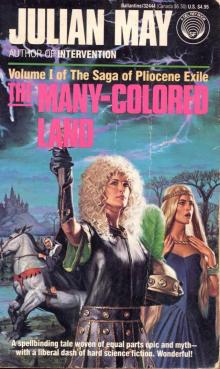 The Many-Coloured Land
The Many-Coloured Land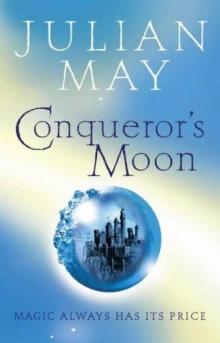 Conqueror's Moon
Conqueror's Moon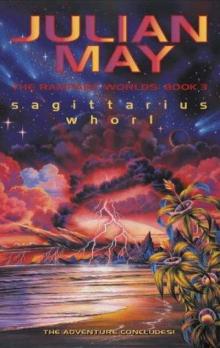 The Sagittarius Whorl
The Sagittarius Whorl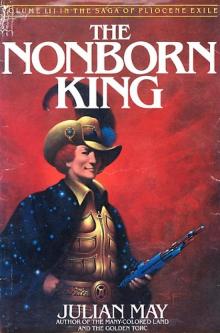 The Nonborn King
The Nonborn King Sky Trillium
Sky Trillium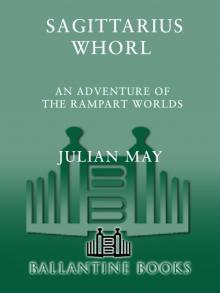 The Sagittarius Whorl: Book Three of the Rampart Worlds Trilogy
The Sagittarius Whorl: Book Three of the Rampart Worlds Trilogy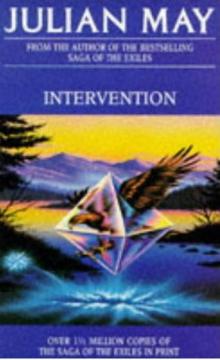 Intervention
Intervention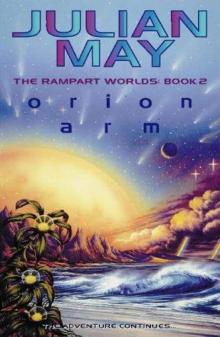 Orion Arm
Orion Arm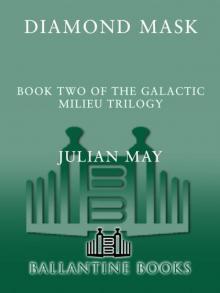 Diamond Mask
Diamond Mask The Golden Torc
The Golden Torc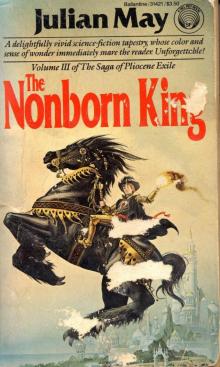 The Noborn King
The Noborn King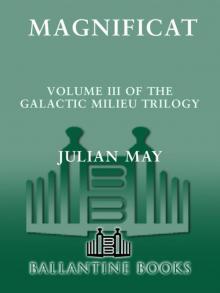 Magnificat
Magnificat Jack the Bodiless
Jack the Bodiless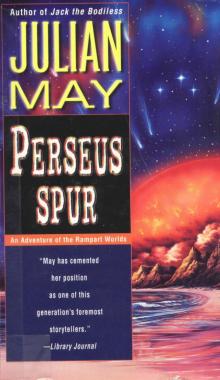 Perseus Spur
Perseus Spur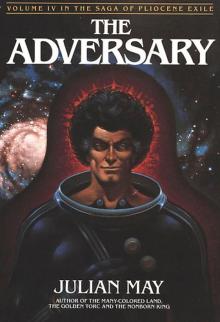 The Adversary
The Adversary Sorcerer's Moon
Sorcerer's Moon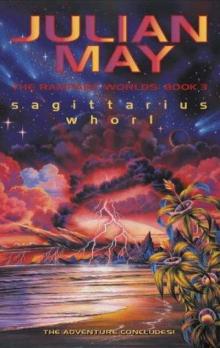 Sagittarius Whorl
Sagittarius Whorl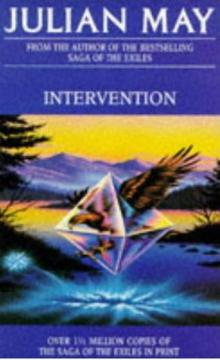 The Intervention (Omnibus)
The Intervention (Omnibus)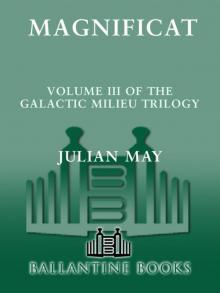 Magnificat (Galactic Milieu Trilogy)
Magnificat (Galactic Milieu Trilogy)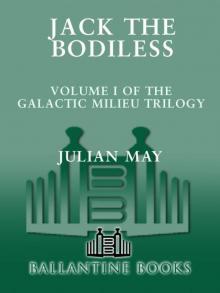 Jack the Bodiless (Galactic Milieu Trilogy)
Jack the Bodiless (Galactic Milieu Trilogy)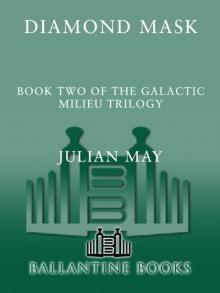 Diamond Mask (Galactic Milieu Trilogy)
Diamond Mask (Galactic Milieu Trilogy) The Many-Coloured Land sope-1
The Many-Coloured Land sope-1